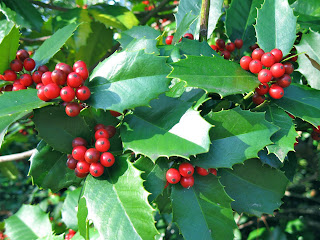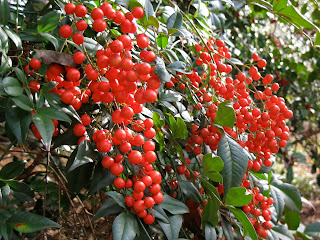During December, our attention turns toward celebrating the holiday season with friends and family. Often decoration of our home is included in that celebration! In addition to the usual Christmas tree, people enjoy embellishing mantels, mailboxes, stair railings, doors and frames. Basically any blank surface can be adorned with the beautiful greenery and fruit on display this time of year to highlight areas of your home. Why not use plant materials with natural, ornamental value to bedazzle your space?
Here are a few choices which I think are particularly beautiful and would provide the perfect “green” touch to your holiday decorations!
CONIFERS
Include trees and shrubs with narrow needle like or scaly “leaves”, cones and are typically (though not always) evergreen. In this group would be cypress, juniper, pine, and cedar, among others. All conifers bear seeds in cones or in cone like structures (juniper berries for example) and the waxy foliage holds up well after being cut and used for decoration. Here are some noteworthy conifers:
Leyland Cypress
Cupressocyparis leylandii
Soft, graceful, feathery foliage drapes and shapes as desired and can be used on mantels, stair railings or door frames. Its vivid green foliage is offset by sparse, tiny cones. Holds its color well as it dries. Many also use this as Christmas trees; however, I find the needles and branches too pliable to hold heavy ornaments. This is a fast growing TREE that is evergreen and used often for screening or hedging. Give it plenty of room on your property. Average size is 65 feet tall and 15 feet wide.
Arizona Cypress
Cupressus arizonica
Amazing silvery, blue spiky needles are offset against striking cinnamon bark. Cut branches placed in a copper urn or planter would add a cool alternative to typical greenery. ‘Carolina Sapphire‘ offers steely blue needles and a broad symmetrical form. The foliage on this medium sized tree is stiffer and more structured than the Leyland Cypress.
Junipers
Juniperus
This genus has everything from low ground covers to tall trees and produces fleshy, berry like fruits instead of woody cones. The foliage consists of small prickly needles ranging in color from silvery blue to a deep, dark green. Often used in wreaths, but also try cutting some branches for mailbox decoration. Holds color well after being cut. If planting in your landscape, plant in full sun and will grow in virtually any soil. ‘Blue Point‘ Juniper is a nice columnar shrub and ‘Brodie‘ or ‘Idyllwild‘ are improved cultivars of the native tree, Eastern Red Cedar (Juniperus virginiana).
Canadian or Eastern Hemlock
Tsuga canadensis
Loose, graceful, drooping branches bear tiny, delicate cones among the short, medium green needles. Overall shape is exactly like the “typical” Christmas tree form. As the name implies, this tree is native to North America and prefers a cool environment. Birmingham is about the furthest south this tree will tolerate and here must have moist, rich soil and a shaded, forested setting. Gets fairly tall and wide - so give this tree some space!
Loblolly Pine
Pinus taeda
You see this pine all over our area! Medium sized, rust brown cones in clusters of 2-5 are found among the soft, pliable, yellowish green needles. I wanted an evergreen base for my front planters to build my arrangement and this worked perfectly because I could shape the needles to the curve of the planter. Also effective as a spray in mailbox decoration. Think twice before bringing cut branches indoors as sticky sap is a nuisance.
Colorado Blue Spruce
Picea pugens
My neighbor has this tree and it is most unusual. A member of the pine family, it has silvery blue needles on stiff, dense, horizontal branches forming a pyramidal medium sized tree. I can only imagine what beautiful arrangements and decoration she may have using branches cut from this beauty. This holiday, they have lights strung on the tree and it is truly stunning in the front yard this season.
Deodar Cedar
Cedrus deodara
This cedar is also a member of the pine family and is a large, fast growing tree. The cones are most unusual and grow among the softer, lighter textured leaves. I am not sure I would ever recommend planting this in a home landscape as it can overpower the yard, but do appreciate the beauty of the foliage and cones as decoration.
Japanese Cryptomeria or Cedar
Cryptomeria japonica
This has quickly become one of my favorite trees to harvest greenery from for decoration. Its short, spiky needles on fingerlike projections terminate in tiny cones. I would use these branches as graceful, drooping additions to any holiday arrangement. I observed some in a mailbox mixture and it provided the perfect touch to the natural, loose look. Beware how you cut from these trees, though, so you do not ruin the shape or leave bare areas due to excessive trimming. Easy to grow this excellent, stout specimen tree has peeling, reddish brown bark.
EVERGREENS
While many of the conifers we discussed above are “evergreens”, here we are talking about broad leaved evergreens which never lose all their leaves at one time. Although they do shed their foliage regularly, it is not as noticeable since some leaves are maintained, giving the appearance of being green throughout the year. Many also have the added interest of seed pods or berries and provide shelter and food for wildlife.
Magnolia
Magnolia grandiflora
Coarse, large glossy leaves create a dramatic display for holiday decoration. Use them on mantels, planters, mailboxes! The lustrous, deep green whorls of leaves can have the added bonus of a velvety brown underside. The Southern Magnolia is a staple in the South and thanks to smaller cultivars, even the tiniest yard can find a magnolia which will complement the landscape. Some of these smaller cultivars are: ‘Little Gem', ‘Bracken’s Brown Beauty’ and ‘Teddy Bear’.
Boxwood
Structured, evergreen plants that have been used for centuries in formal plantings as hedges, walkway edges, and foundation plants. The evergreen, lance shaped leaves on stems can be cut and also used in holiday decoration. While the foliage does tend to dry out quicker when cut than the junipers or cypress, one can still find boxwood used in wreaths and kissing balls!
Common
Buxus sempervirens
Korean
Buxux microphylla koreana ‘Winter Gem’
BERRIES
Nandina
Nandina domestica
Another tough native with the added bonus of clustered, vibrant red berries that droop like grapes from branch ends. Berries supply winter food for birds - or - make the best long-lasting berry decoration in holiday arrangements. Berry branches are easily harvested from the shrub. From mailboxes - to mantels - to urns this is the staple berry designers use when red berries are needed without the addition of leaves.
Holly
Ilex
Few plants produce more reliable berries and are as hardy and dependable as this genus. Nearly all hollies are either male or female, with the female plants bearing fruit with a male pollenizer plant nearby. Most, though not all, are evergreen and thrive in sun (best berry production) to part shade. They tolerate heavy shearing which should be done in winter to shape, control size and use as holiday decoration! There are hundreds of species, but here are a few of my favorites!
Lusterleaf Holly
Ilex latifolia
Large, oblong leaves resembling those of a Magnolia are set off by clustered, matte scarlet berries. Use these in mixed arrangements for a “wow” factor!
Foster Holly
Ilex x attenuata ‘Foster’
A narrow, conical plant which bears plentiful “fire engine” red berries. Small leaves terminate in a single spine. Habit and form very similar to a Yaupon Holly.
Possumhaw
Ilex decidua ‘Warren’s Red’
Pale gray branches bear beautiful, bright flaming berries along the deciduous stems. This makes a striking addition to any arrangement - but beware that these berries are more prone to drop earlier when branches are cut than some of the evergreen cousins. Medium growth rate and while technically considered a shrub - can also be used as a small tree.
Yaupon Holly
Ilex vomitoria
Native Americans transplanted these because they made a ritualistic tree from the roasted stems and leaves to “cleanse” or “purge” - hence the name - vomitoria. While I do not recommend that for your holiday season - I do recommend using the cut branches bearing shallow toothed leaves and petite, brilliant red berries in your holiday decorations!
Other Hollies of Note include Burford, Nana Burford, Mary Nell, and Nellie R Stevens. Countless species with breathtaking berry crops!
Please be aware that the berries featured here are for ornamental value only. I would never recommend placing them somewhere where pets or small children might confuse them with an edible treat.
I hope this information has been helpful to you. As always, Hilary Ross of Mater Natura Designs is available for planning, designing or consultation for your garden and landscape needs AND wants! Let me know if I can be of any assistance to maximize the enjoyment of your garden and landscape.
Mater Natura Designs
Mother Nature Garden Designs
Creating classic and timeless designs for formal to informal gardens
Contact me at
maternatura.designs@gmail.com






















No comments:
Post a Comment